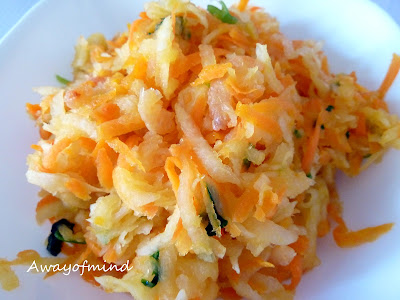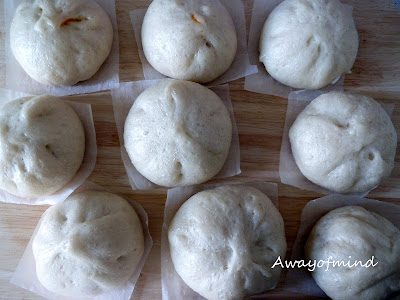Recently quite lazy in update my posting, just concentrate doing my kitchen play. WT are back from overseas posting, I no longer able to sit in front of my computer for the whole night... I think he should be happy to see this remark.
Let me present to you my successful Jicama Bun. Jicama or Pachyrhizus erosus or commonly referred to as "yam bean" or well known as "Bang Kuan" to the ethnic Chinese in Southeast Asia is a kind of crispy , sweet, edible root. It should be peeled to reveal the white inside. It is excellent raw for salads, but I prefer it to be cooked. Usually in Asia, we used it in "popiah" or spring roll.
The making of this bao is inspired by Vivian from Vivian Pang Kitchen after seeing her using Sponge Dough Method for the bao. This is my first time trying out Sponge Dough Method and yes, I love the result! I'm using Vivian's bao recipe and steps for the bao and as for the filling is from Ah Tze's kitchen play :)
Recipe from Ah Tze's Kitchen Play
Bao Filling Ingredients:
1 small jicama, peeled and grated
1/2 carrot, peeled and grated
1 tbsp dry prawn, chopped
some coriander
1 tbsp sesame oil
2 tbsp sugar
1 tsp salt
100 ml water
Steps:
1. Heat up wok and add sesame oil. Add dry prawn, stir fry for 1 mins.
2.Add grated jicama and carrot, stir fry for 2 mins, then add water, sugar, salt and coriander. After the jicama and carrot are soften, leave the vegetable to simmer under medium heat for another 5 mins. The water should have dry off. Set aside to cool.
Bao ready for steaming.
Recipe adapted from Vivian Pang Kitchen
Ingredients:
(A) overnight sponge dough
60g plain flour
30-40ml water (used 40ml)
1/2 tsp yeast
1 tsp sugar
(B) Pau dough
110ml water
1/4 tsp yeast
1/4 tsp salt
1 tbsp sugar
2 cups plain flour (used 400g)
Steps:
Sponge Dough
1. Mix all till form a dough. Immediately store in greased plastic bag (no proving needed). Make a tight knob without leaving any space for the dough. Store in fridge at least 4 hours. It can be kept up to 7 days.
2. Thaw it for 10-15 minutes at room temperature before use. You can prepare the sponge dough one night before. Tear into small pieces before use.
Pau Dough
1. Put all ingredients from (B) except flour into a pan. Stir to mix. Follow by pieces of overnight sponge dough. 2. Add in the flour and knead into a smooth dough. Cover and rest for 10 minutes.
3. Transfer to working surface. Divide the dough into 12 portions and mould into balls. Flatten balls into round shape. Wrap in filling and place on lined paper.
4. Rest the pau in steamer for 15 minutes.
5.Bring the water to boil. Steam with medium low heat for 10 minutes. Once the steaming time is over, off the heat, leave the pau inside the steamer for 1 minute before open the lid.







I don't think I've had jicama cooked, but it sure made a delicious looking filling for your buns :)
ReplyDelete我喜欢你炒的沙曷。。颜色很美很吸引人。。yummy !
ReplyDeletethe bun looks fluffy and love the vibrant colors of the filling! rainbow bun! hehe
ReplyDeleteI also love 菜包very much and definitely like to try using plain flour.
ReplyDeletethat's not lazy of you (: you make the bun so lovely and delicious! (: i want to eat it!
ReplyDeletebeautiful paus Ah Tze! and i love the fillings!
ReplyDelete好健康的点心。很喜欢菜包给与的饱足感,但却没有吃太多肉的油腻和罪恶感!感谢分享!
ReplyDeleteYour pau looks very soft and fluffy. I'm glad you like the recipe. And I like your colourful and healthy filling.
ReplyDeleteI want one! Looks absolutely delicious!
ReplyDelete>>Lizzy, is it easy to get jicama at your place?
ReplyDelete>>苏联,那颜色是被酱汁给染橙了哟。。:)
>>Jean, thanks!I love the result from Sponge Dough Method, it produces fluffy buns :)
>>Ann, please try this out, plain flour can do a good job too! I think Sponge Dough Method does help a lot. My bao puffed up quite high, not like the one I made in "a blossoming flower".
>>
>>Jasmine, come, come, come, have reserved for you :)
ReplyDelete>>Jess, the filling is crunchy and go well with the soft bun!
>>travellingfoodies,对呀,这菜包每次我都吃上倆个因没罪恶感嘛 :D
>>Vivian, thanks for the beautiful bao's recipe, I love it!
>>Jet, haha, want to try make one? ^_^
i also like these kind of fillings besides char siew pau. Looks very nice!
ReplyDeleteMy daughter was requesting for this last night... :) nice fluffy pau
ReplyDelete你家最近出产好多包子呐,拿来当早餐肯定一流^^
ReplyDelete我的最爱。。。我最爱沙葛包里面的沙葛。。。。每次都只吃它而已。。。哈哈哈。。。
ReplyDeleteThis is interesting, I have never eaten this before, I think. :)
ReplyDelete我很喜欢这款包子的,可是想到要炒馅,我就做不来了。。
ReplyDeleteAh tze!! Your bao(s) look so soft!! Love it!
ReplyDeleteAnd I've bought ingredients to make bao sometime ago, but I've forgotten all about it..thanks for remind me with your post!! =)
These buns are so lovely. I love the combination of its filling, the colours is so beautiful.
ReplyDelete>>Lena, it tastes good too! I love the crunchy filling!
ReplyDelete>>Lisa H, welcome and thanks for the comment!
>>鲸鱼,是呀!倆人吃上好几天的菜包早餐 :)
>>Joelyn, 沙葛包是健康的哟!
>>Hanushi, this is a nice one! Try it out!
>>茄子,这馅不难炒啦!
>>Coraine, try it out and let me know the result!
>>Zoe, thanks!
Hi Ah Tze,
ReplyDeleteYour bao looks amazingly soft and fluffy. May I know what kind of yeast are you using? Instant dry yeast or active dry yeast?
As for the flour, I understand that 2 cups are around 250g, but you're using 400g. Wouldn't it be too much flour? And how long do you need to hand-knead till smooth? How do you tell that sufficient kneading is done? Thank you.
PG
Hi PG,
ReplyDeleteThis bao used Instant dry yeast. Overnight sponge dough was added to the bao, this create a very sticky dough, I gradually added 400g of flour to get the desired bao dough.
It depends on the contains usually I wouldn't count how long should I knead the dough. The dough should feel soft and smooth when touch. Dry dough will result in very hard and dry bao texture. If too dry, gradually add in water.
When pull out a corner of dough, it doesn't break and you can see a clear film dough, this is call elastic dough film. When you knead until this stage means the dough is ready.
Hope this help you in making success bao!